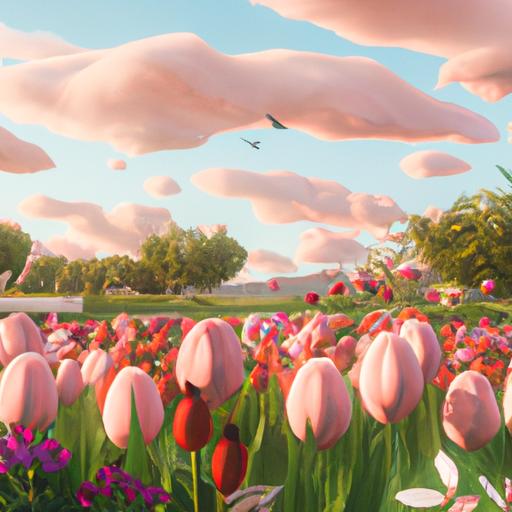Have you ever been in awe of the vibrant colors of a tulip? From the deep purples to the soft blues and pinks, tulips can add a wow factor to any backyard or garden.
Have you ever wondered how these beautiful flowers get their color? In this article, we will be exploring the secrets behind the color of tulips, from the anatomy of the flower to the role of pigments, hybridization, and breeding.
We will also be taking a look at how you can use tulips to dye fabric, how long the colors last, and the different colors of tulips.
Finally, we will look at how to grow and care for colorful tulips.
Read on to discover the secrets behind the color of the stunning tulip!.
Table of Contents
Short Answer
Tulips get their color primarily from pigments in the flowers petals.
These pigments are called anthocyanins, and they come in a variety of colors such as red, blue, purple, yellow, pink, and orange.
Each type of tulip has a unique combination of pigments which gives the flower its distinctive hue.
The petals also contain carotenoids, which are responsible for the yellow and orange colors of some tulips.
Anatomy of a Tulip
Tulips are a stunning flower that come in a variety of colors and shapes.
To understand how they get their color, it is important to first understand their anatomy.
Like most flowers, tulips are made up of several parts: the stem, the leaves, the petals, the calyx, the ovaries, and the stamens.
All of these parts play a role in the tulips vibrant colors.
The stem is the main support for the flower and is typically green in color.
It is made up of several layers of cells, including parenchyma, collenchyma, and sclerenchyma cells.
These cells provide the stem with structure and flexibility.
The leaves of a tulip are also green in color and are made up of many layers of mesophyll cells.
These cells contain a special pigment known as chlorophyll, which helps the plant make food from sunlight.
The petals of a tulip are the most colorful part of the flower.
They are typically made up of two layers of cells: the epidermis and the parenchyma.
The epidermis is the outermost layer and contains a special pigment called anthocyanin.
This pigment is responsible for the vibrant colors of tulips.
The parenchyma cells are located beneath the epidermis and contain other pigments, such as carotenoids and flavonoids, which give the petals their color.
The calyx is the green cup-like structure at the base of the tulip.
It is made up of several layers of cells, including the epidermis and the subepidermal layer.
The calyx helps to protect the delicate ovaries and stamens from the elements.
The ovaries and stamens of a tulip are located at the center of the flower.
The ovaries are the female reproductive organs and contain the egg cells.
The stamens are the male reproductive organs and contain the pollen.
Together, these two structures help the tulip reproduce.
Now that we have a better understanding of the anatomy of a tulip, we can begin to explore how it gets its color.
The Role of Pigments

Tulips come in a range of vibrant colors, from bright yellow to deep purple hues.
But how do they get their color? It all comes down to the pigments in their cells.
Special pigments, known as anthocyanins, are responsible for the color of tulips, and can range from red to blue and even purple.
By manipulating the pigments through careful hybridization, tulip breeders can create a vast array of stunning varieties.
These pigments are found in the cells of the petals, and the color is determined by the ratio of the two main pigments, anthocyanin and flavonol.
The amount of each pigment is what creates the stunning hues of the tulips.
For example, a tulip with more anthocyanin will appear to have a redder hue, while one with more flavonol will appear to have a yellower hue.
This is why tulips can come in so many different colors.
In addition to the pigments, the environment in which the tulips are grown can also play a role in their color.
For example, if the tulips are grown in a shady area, they will tend to have a lighter hue.
On the other hand, tulips grown in direct sunlight will often be more vibrant and colorful.
Another way to manipulate the color of tulips is to dye them.
Tulips can be dyed with special dyes to create even more diverse and unusual colors.
However, these colors are not as vibrant or long-lasting as the natural colors produced by the pigments.
While the vibrant colors of tulips are beautiful, they do have a limited lifespan and will eventually fade away.
This makes them a fleeting beauty, but one that is sure to bring joy while they last.
Hybridization and Breeding
Tulips come in a range of stunning colors, from bright yellow to deep purple.
But how do they get their color? The answer lies in their genetics.
Each tulip is made up of cells that contain special pigments, known as anthocyanins, that are responsible for their vibrant hues.
Through careful hybridization, tulip breeders can manipulate the pigments to create unique and beautiful varieties.
Hybridization and breeding techniques are used to create new varieties of tulips with more vibrant colors.
By carefully cross-pollinating different varieties of tulips, breeders can manipulate the genetics of the plant to create new, more colorful varieties.
This hybridization process allows for the creation of new and unique tulip varieties, such as the fringed tulip and the parrot tulip.
In addition to hybridization, tulip breeders also use dyeing techniques to create even more unusual and varied colors.
By dipping the tulips in dyes with different hues, the breeders are able to create a wide range of colors, including pink, blue, purple, and even black.
This dyeing process is often used to create the vibrant and eye-catching tulips that are seen in gardens and flower shops around the world.
While the vibrant colors of tulips are beautiful, they do have a limited lifespan and will eventually fade away.
However, with careful hybridization and dyeing techniques, tulip breeders are able to create unique and stunning varieties that can last for many years.
So next time you admire a beautiful tulip, you know that its the result of careful breeding and dyeing techniques.
Tulips and Dye

Tulips are not only known for their vibrant colors, but also for the fact that they can be dyed to create even more unique and interesting hues.
This process is known as tulip dying and it involves soaking the tulip in a solution of dye.
The dye is typically a combination of food coloring and water, which allows the color to be absorbed into the petals.
Once the tulip has been dyed, it can be arranged in a variety of ways to create beautiful arrangements.
Tulip dying can also be used to create special effects, such as ombre and two-tone petals.
Tulip dying is a great way to give a special touch to any floral arrangement and can be used to create a unique look for any occasion.
How Long Do Tulip Colors Last?
When it comes to the lifespan of tulip colors, it depends on the type of tulip and how it was dyed.
Generally speaking, the colors of tulips tend to last for a few weeks before fading away.
Some tulips, such as varieties that are naturally colored, may last for a few months before the colors start to fade.
When it comes to dyed tulips, the colors usually last for a few days before beginning to fade.
The reason for this is because the pigments in tulips are not permanent and break down over time.
As the pigments break down, the colors begin to fade away.
To extend the lifespan of tulip colors, it is important to care for them properly.
This includes keeping them away from direct sunlight, as the UV rays can cause the colors to fade faster, as well as ensuring they are kept in an environment with proper humidity.
Additionally, tulips should be watered regularly and given adequate nutrition to help them last longer.
All in all, while the vibrant colors of tulips are beautiful, they do have a limited lifespan and will eventually fade away.
With proper care, however, the colors of tulips can last for several weeks or even months before beginning to fade.
Different Colors of Tulips

Tulips come in a wide range of beautiful and vibrant colors, from bright yellows and oranges to deep purples and reds.
Each tulip color is unique and special in its own way, and the source of each color is the same: special pigments known as anthocyanins.
Anthocyanins are responsible for the bright and colorful hues of tulips.
They are naturally occurring pigments found in plants and are produced as a result of a reaction between light and certain compounds.
The amount and type of anthocyanins present in a tulip will determine its color, and this is why tulips can come in so many different shades.
Tulip breeders have also been able to manipulate the pigments to create unique and beautiful varieties.
By carefully selecting and cross-breeding different types of tulips, they are able to produce stunning and unusual colors.
In addition, tulips can also be dyed to create even more diverse and interesting hues.
However, it is important to remember that tulips vibrant colors are only temporary.
Over time, the pigments will fade away and the tulips will eventually lose their color.
So, if you are looking for a long-lasting burst of color, it may be wise to choose a more permanent option.
Growing and Caring for Colorful Tulips
Tulips are some of the most beloved and iconic flowers in the world, and it’s no wonder why.
With their vibrant colors and unique shapes, they add a touch of beauty and elegance to any space.
But how do they get their color? The answer lies in their genetics.
Each tulip is made up of cells that contain special pigments, known as anthocyanins, that are responsible for their vibrant hues.
Through careful hybridization, tulip breeders can manipulate the pigments to create unique and beautiful varieties.
Tulips can also be dyed to create even more diverse and unusual colors.
When it comes to growing and caring for colorful tulips, there are a few things to keep in mind.
First, it’s important to choose the right type of tulips for the environment you’re growing them in.
Different types of tulips prefer different types of soil, light levels, and temperatures, so make sure you do your research and select the varieties that are best suited for your space.
It’s also important to provide your tulips with adequate nutrition, such as fertilizer, as this will ensure they remain vibrant and healthy.
Additionally, make sure to provide your tulips with enough water, as they will need it to thrive.
Finally, it’s important to remember that while the vibrant colors of tulips are beautiful, they do have a limited lifespan and will eventually fade away.
To keep your tulips looking their best, it’s best to pick them at their peak and enjoy them while they last.
With the right care, you can enjoy the beauty of these colorful flowers for many years to come.
Final Thoughts
The vibrant colors of tulips are beautiful, but they are only temporary.
Through careful hybridization and dyeing, tulip breeders can manipulate the pigments within the tulips to create unique and colorful varieties.
Whether you are a gardener or simply an admirer of tulips, understanding the process and science behind their colors can help you appreciate the beauty and complexity of these flowers even more.
So, why not try growing and caring for your own colorful tulips and discover the beauty of these flowers for yourself?.

